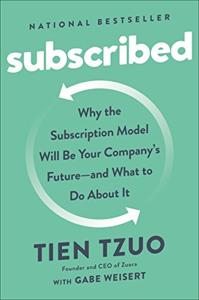
Want to learn the ideas in Subscribed better than ever? Read the world’s #1 book summary of Subscribed by Tien Tzuo, Gabe Weisert here.
Read a brief 1-Page Summary or watch video summaries curated by our expert team. Note: this book guide is not affiliated with or endorsed by the publisher or author, and we always encourage you to purchase and read the full book.
Video Summaries of Subscribed
We’ve scoured the Internet for the very best videos on Subscribed, from high-quality videos summaries to interviews or commentary by Tien Tzuo, Gabe Weisert.
1-Page Summary of Subscribed
Overview
Business revolutions can change the world. Adam Smith’s division of labor, for example, was a big part of the industrial revolution. And technological progress in the 1900s wouldn’t be possible without Henry Ford and his assembly line.
Today, we’re in the midst of a great transformation. The future business model will be based on subscription-based services. These are companies that provide their services for a monthly fee and are among the most popular ones online.
The subscription economy is a new economic model that’s transforming the way we live. It’s built on the premise that people want access to services rather than ownership of things. One expert who has spent his career studying this phenomenon and helping companies transition to it is Tien Tzuo, whose insights are highlighted in these key points: data revolution fuels the subscription-based economy; internet of things will transform manufacturing; and how to start transitioning your company into a subscription model.
Big Idea #1: Ever more companies are moving to subscription models to reflect their customers’ changing needs.
Tien Tzuo argues that business school is a waste of time. His reasoning? Most of what you learn at business school is to create hit products and sell them. The world has changed, so this doesn’t apply anymore. He suggests that subscription-based models are the future, because they offer consumers more options for how they consume your product or service.
There are two main points to remember – access and service. People today aren’t as interested in owning things; they want the ability to use them when they need them. Cutting-edge companies don’t sell CDs or cars, but rather offer people subscriptions that give them access to music or transportation whenever they want it. Companies like Uber, Spotify and Netflix have figured out how to make money by offering this kind of subscription service instead of selling physical products directly.
Services are more valuable than physical products. For example, the music on a CD is more important than the silver disc itself, and getting from one place to another (such as traveling) is more important than the vehicle that facilitates such travel. When companies focus on what their customers want and need, they’re able to provide better service.
Companies need to shift their focus from sales to customer retention. This is because the tastes of customers are always changing, so if companies don’t change with them they’re going to lose out.
Only 12 percent of the companies that were on Fortune 500 in 1955 are still there. The ones that are left have undergone major changes.
For instance, GE used to be a company that made light bulbs and fixtures. Today, it’s more known for its data services.
IBM rose in the ranks from sixty-first to thirty-second. It did this by selling commercial scales and measuring equipment, then moving on to IT services and business subscriptions.
So, what happened to the 88 percent of companies that didn’t make it into the new Fortune 500? They were unable to adapt quickly enough.
Big Idea #2: The video, music and even retail industries are already dominated by subscription services.
Netflix, Spotify and Amazon are some of the most popular brands today. It’s hard to imagine life without them. They have a huge impact on our lives and how we live it. So what was it that made these companies so successful?
There has been a lot of growth in the access to music and video with the arrival of file sharing sites like Napster. The internet was also instrumental in this growth spurt, which really began around 2000. This was a scary time for big film studios and record labels because they worried that their business would be destroyed by these new companies. In response, they went on an offensive legal crusade against them.






